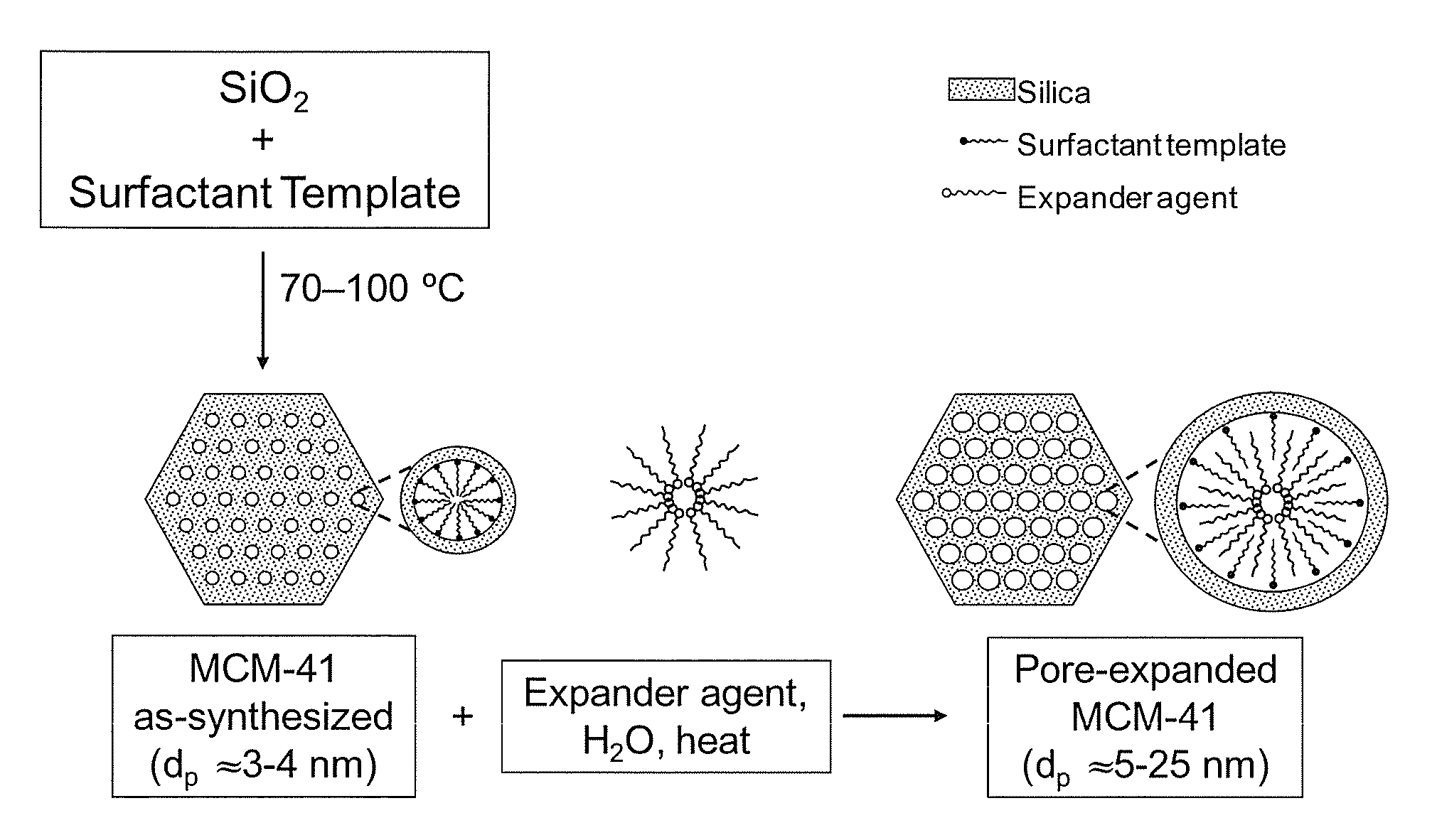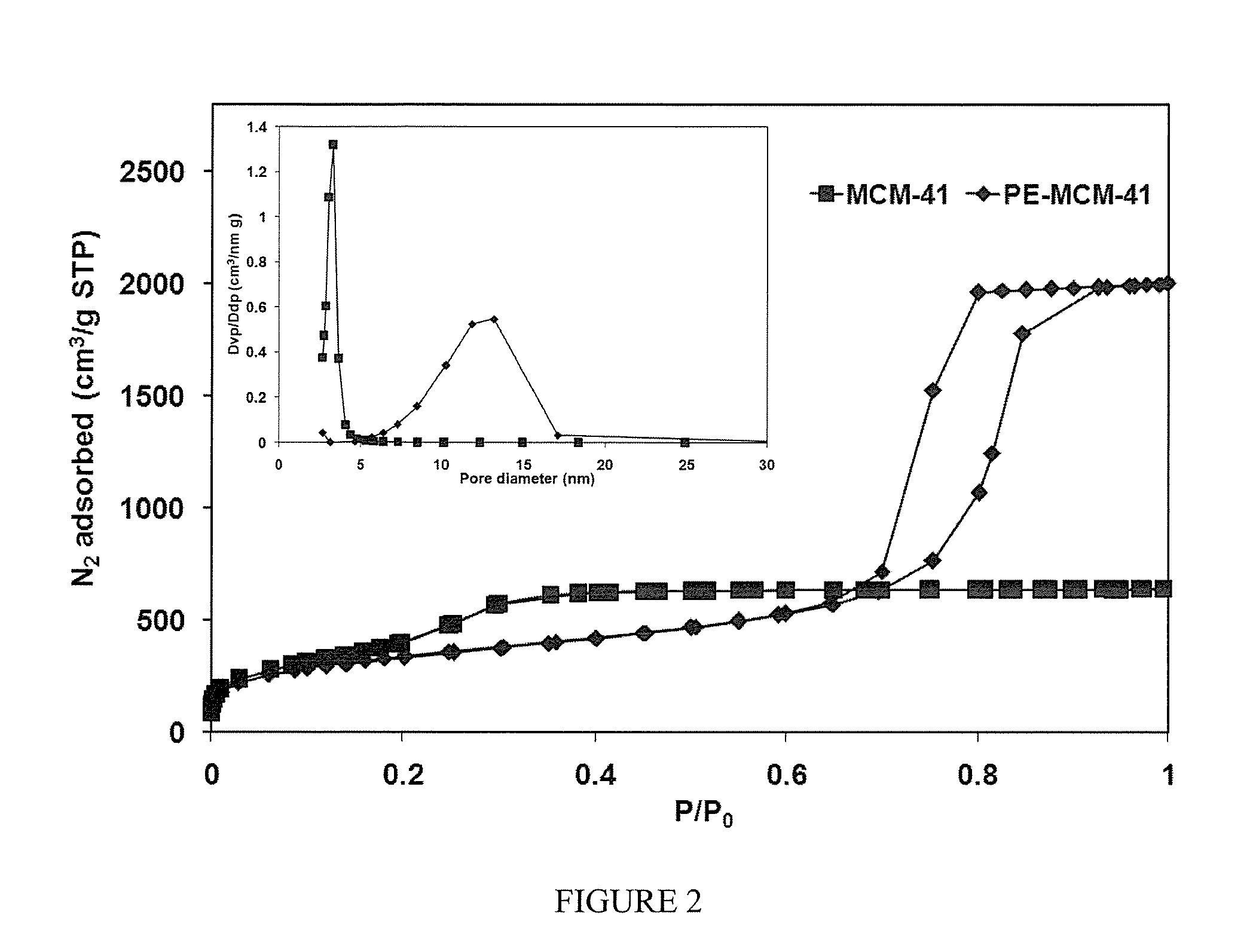Materials, methods and systems for selective capture of CO2 at high pressure
a technology of selective capture and co2 at high pressure, which is applied in the field of selective capture of carbon dioxide and other acid gases, can solve the problems of high regeneration cost of absorbents, and achieve the effect of enhancing the selectivity toward co2 vs
- Summary
- Abstract
- Description
- Claims
- Application Information
AI Technical Summary
Benefits of technology
Problems solved by technology
Method used
Image
Examples
example 1
Preparation of MCM-41-X Mesoporous Silica
[0061]FIG. 1 shows the procedure for the synthesis of periodic mesoporous MCM-41 silica. MCM-41-X silica where X is the synthesis temperature in degree celsius was prepared in the presence of cetyltrimethylammonium bromide (CTAB) using the overall mixture composition: 1.0 SiO2:0.29 TMAOH:0.21 CTAB:60 H2O. In a typical synthesis, 1.76 g of tetramethylammonium hydroxide (TMAOH) (25%) was diluted with 72 g of water before adding 5.1 g of CTAB under vigorous stirring. After 15 min, 4 g of Cab-O-Sil silica was added. The gel obtained after stirring for an additional 30 min was transferred into a Teflon-lined autoclave, and heated statically under autogenous pressure for 40 h at a temperature within the range of 298 to 403 K. The obtained materials were filtered washed extensively, dried, and calcined at 813 K. The structural properties of MCM-41-100 as determined by nitrogen adsorption were: 1490 m2 / g, 0.99 cm3 / g, 3.3 nm for the surface area, pore...
example 2
Preparation of Pore-Expanded MCM-41 (PE-MCM-41) Silica
[0062]FIG. 1 shows also the procedure for the post-synthesis pore expansion of MCM-41. The expander agent used for the preparation of PE-MCM-41 was dimethyldecylamine (DMDA). More details about the procedure may be found elsewhere (Serna-Guerrero and Sayari 2007; Harlick and Sayari 2007). Under appropriate conditions, i.e., DMDA / MCM-41 ratio, temperature and time of the post-synthesis hydrothermal stage, the pore size of MCM-41 can be expanded from ca. 3 nm up to ca. 25 nm. As shown earlier (Harlick and Sayari 2007), pore size tuning is critical for improved CO2 adsorptive properties at high pressure. The structural properties for a PE-MCM-41 sample as determined by nitrogen adsorption were: 1230 m2 / g, 3.09 cm3 / g, 11.7 nm for the surface area, pore volume and pore diameter, respectively (FIG. 2).
example 3
Method for Measurement of Adsorption Properties and Kinetics
[0063]Adsorption equilibrium and kinetics measurements of pure CO2 were performed using a Rubotherm gravimetric-densimetric apparatus (Rubotherm, Bochum Germany), composed mainly of a magnetic suspension balance (MSB) and a network of valves, mass flowmeters and temperature and pressure sensors. It operates both in closed and open loops. In a typical adsorption experiment, the adsorbent was weighed and placed in a basket suspended by a permanent magnet through an electromagnet. The cell in which the basket is housed was then closed, and vacuum or high pressure was applied. This system is able to perform adsorption measurements in a wide range of gas pressure from 0 to 60 bar. The adsorption temperature may also be controlled within the range of 298 to 423 K. The clean (outgassed) adsorbent is exposed to flowing pure CO2 at constant temperature at a rate of 100 ml / min. In a typical experiment for kinetic measurements, the ga...
PUM
| Property | Measurement | Unit |
|---|---|---|
| pore diameter | aaaaa | aaaaa |
| pore diameter | aaaaa | aaaaa |
| pressure | aaaaa | aaaaa |
Abstract
Description
Claims
Application Information
 Login to View More
Login to View More - R&D
- Intellectual Property
- Life Sciences
- Materials
- Tech Scout
- Unparalleled Data Quality
- Higher Quality Content
- 60% Fewer Hallucinations
Browse by: Latest US Patents, China's latest patents, Technical Efficacy Thesaurus, Application Domain, Technology Topic, Popular Technical Reports.
© 2025 PatSnap. All rights reserved.Legal|Privacy policy|Modern Slavery Act Transparency Statement|Sitemap|About US| Contact US: help@patsnap.com



